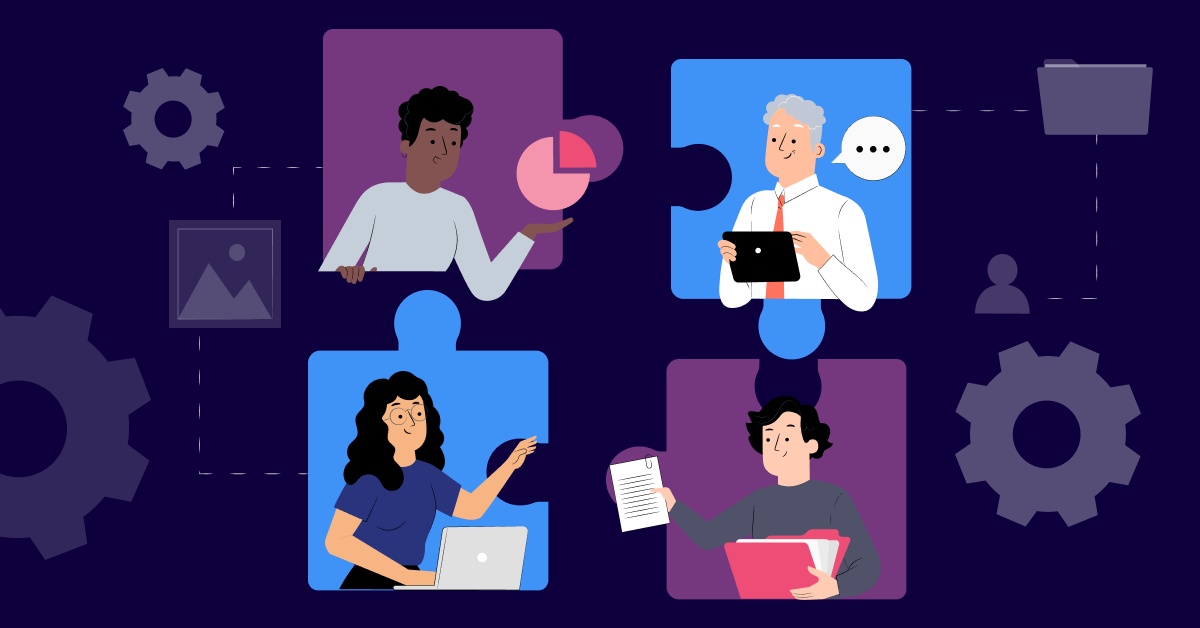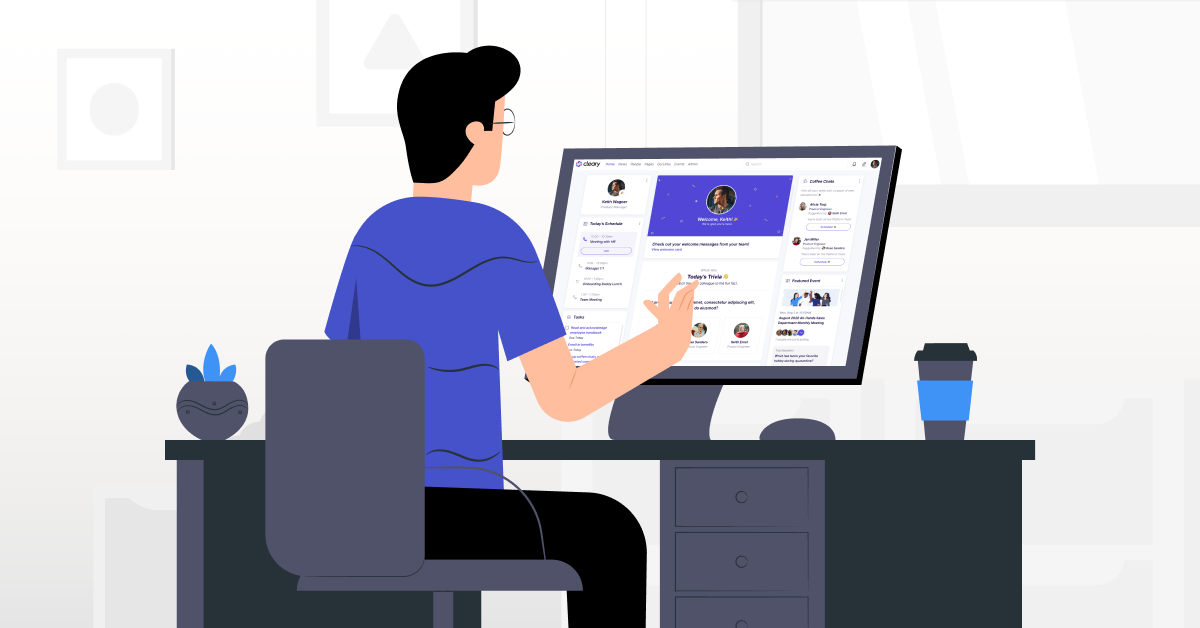What are the biggest benefits of building a distributed workforce? Access to a broader talent pool and the promise of better work-life balance top the list for many companies.
However, building a productive work environment for a virtual team doesn’t happen by accident. It requires careful planning and must be supported by vigilant leaders dedicated to identifying and troubleshooting communication issues that negatively impact their teams.
In this article, we’ll cover:
- Five everyday situations that can signal an issue.
- Why these distributed workforce issues exist and how they hurt productivity.
- How innovative people teams are fixing these issues with a better digital employee experience.
Let’s start at the beginning – when a new employee joins the team.
Sign #1: A new Sales Ops Admin started at the company six weeks ago — and he’s still not sure who’s supposed to be telling him what to do.
There’s a lot involved in designing and executing effective remote onboarding, and it’s difficult to manage. That’s likely why nearly 30% of employees feel like their employers could do better.
In a virtual world, on a new hire’s first day, they open their laptop and wait for someone to notice they’ve made their stealthy Slack debut. There’s no in-person tour of the office, team lunch, or hand-holding. So how does your new employee know what to do next?
Fast-growing ecommerce shipping platform Shippo, a Cleary client partner, strives to deliver a world-class onboarding experience for all new hires. By creating an ‘employee hub,’ they’ve been able to streamline their virtual new employee onboarding with a dozen new employees joining every week, all working in a hybrid environment across 13 metropolitan areas.
Teams like Shippo leverage their ‘hub’ to celebrate new hires by sending out a company-wide announcement, welcoming them to the team. Hiring managers give new team members easy access to everything they need to be successful. This often includes things like a welcome video from the team or CEO, a first-day checklist with links to forms they need to complete, access to an interactive org chart, links to team member profiles, and a detailed repository of department content and ‘what to expect’ documents.
With a “go to” place for onboarding, new hires can feel confident in their ability to acclimate to their new role, integrate with their team, and hit the ground running.
Sign #2: The company just “announced” a major strategic shift last Friday afternoon, but the entire APAC sales team didn’t know about it…”
Companies across the world have been forced to make major pivots since COVID hit. Employees were banished from offices and found themselves working from makeshift desks on their couches and at their dining room tables. Meanwhile, people teams worked feverishly to construct a productive virtual environment for their fast-moving, fast-growing teams.
With the wheels already in motion, many companies chose to remain partially or fully virtual, opening their doors to a global talent pool. But are they ready to support a globally distributed workplace? In many cases, no. Global brands have unique needs that aren’t addressed by a ‘one-time-zone-fits-all’ solution.
However, payment processor Square – named a 2020 Top Global Employer Brand by Hired – was ready to meet the challenge. Determined to find the best tools to effectively support an asynchronous workforce, Square adopted a fully branded, centralized, virtual meeting place that provides tools to support distributed teams. How can a virtual hub help?
For one, employees can see what time it is in teammates’ international time zones at a glance, bringing awareness to the best timing for communications, maybe even eliminating surprise wake-up calls. But even more importantly, team members can create asynchronous All Hands, initiative-based meetings, and brainstorm work rooms with the click of a button.
In these rooms, invited participants can contribute to collaborative agendas, ask questions, and post updates. All live meetings can be recorded and distributed across teams to make sure everyone who needs to be in the know – is. And perhaps most importantly, by using topic and geo-tagging, companies can effortlessly build a searchable repository of contextual content that’s lightyears ahead of the dusty old ‘intranets’ of yesteryear.
These tools all work together to provide a frictionless work environment that keeps distributed teams aligned and productive across time zones and across the globe.
Sign #3: A fearless marketing leader searched Google Docs for his ‘2021 product roadmap’ and was met with 105 results…
Have you ever seen the movie Labyrinth? The imaginary maze world is what we imagine the depths of a Google drive account looks like at a hypergrowth company.
When things move fast, organized naming conventions and folder structures are often the first casualties. If you have to count on each team member to be disciplined enough to build out a logical file hierarchy – and consistently file documents appropriately – you’re doomed.
Now, add the fact that each department has twenty-five different platforms they regularly log into at work, and you’ve really got yourself a mess. Often, remembering the file name isn’t even the real issue… it’s remembering which platform to search.
Fruitless searching may be the biggest time-waster that impacts businesses on a daily basis. Just think of all the time each of your employees spends each day trying to find that one document from six months ago. Now multiply whatever amount of time you came up with across every workday for the year. Yikes, right? Teams are losing literal days of productive time trying to find things in your content labyrinth.
Now, imagine a world where all files are categorized and bookmarked in the company filing cabinet. In this glorious world, employees can globally search people, resources, company updates, links, and events in one place. This world exists!
No more “Ah crap – was that on Slack or in my email? Or was it on Asana…” followed by ten minutes of frantic keyword searching… while you’re screen sharing on a live Zoom meeting.
Sign #4: An anonymous negative Glassdoor review has the office abuzz; meanwhile, employee engagement survey results have the HR team worried.
Driving engagement and connection is possible in a virtual workplace but it requires a deliberate, calculated approach. Suffice it to say, People Ops and Employee Engagement teams have their work cut out for them.
So let’s start with our Glassdoor scenario. How should companies address office chatter in a distributed workforce? Does an executive bring it up during an all-hands meeting hosted on Zoom to address the company at large? Does a company-wide email or Slack message go out?
It’s a delicate situation because once one loud opinion makes its way out into the world – and there’s a chance it came from someone still working within the company – all bets are off until leadership gets involved. It’s ultra-important to nip issues like these in the bud because nothing spreads faster than toxicity in a speculative work environment.
Forward-thinking businesses celebrate transparency and utilize it as a key trust-builder across all levels of their organization. To facilitate this, companies are implementing tools that allow for direct Q&A with executives, which can open doors and help establish trust. These tools also allow companies to capture a pulse check via a real-time feedback survey that encourages employees to share their candid feedback.
Now, let’s look at employee engagement. How do you drive interaction in a virtual world? Two words; start simple.
Companies constantly dump money into employee retention programs – but are they focusing on the right things? More often than not, public recognition of a job well done makes a bigger impact than any reward or gift. In fact, Gallup research reveals that only one in three US employees feels they receive enough recognition for their work, and employees who don’t feel adequately recognized are twice as likely to quit in the next year.
That’s why innovative tech companies like Flexport, Shippo, and PillClub focus on incorporating employee recognition into their employee engagement and retention strategy by building it into their employee’s company identity.
Within their company-branded personalized dashboard, every single employee has a profile that highlights not only what they do but also celebrates their company achievements and displays any and all recognition they receive from co-workers, managers, and executives.
Not everyone wants (yet another) branded coffee mug, but everyone loves kudos!
Sign #5: Constant interruption burnout is real, and no one wants to learn that new feedback system the People Ops team just rolled out (…including the People Ops team).
People used to go to work, do their time, and go home. Once home, no one could reach you. You couldn’t continue to work because your work computer was on your work desk in a building that is not your house. That’s just not the case anymore.
Today we’re bombarded by constant interruptions. This scenario may sound familiar:
It’s the end of a long day of back-to-back meetings, and you finally have five minutes to concentrate on your urgent deadline project – then it happens. Your phone rings, and as you press decline, messages pop up from four different people on Slack. Then, the reminder you set an hour ago pops up, your voicemail notification tone dings, and your doorbell rings, which causes your dogs to start barking. At that moment, you consider closing your laptop in an exasperated huff and giving up for the day.
You decide to check your email instead, only to find that People Ops sent a company-wide message letting everyone know they have to submit a mandatory weekly update through a new platform – starting today.
Employees’ plates are overflowing, and they are not jumping for joy at this news. So what can be done to drive adoption?
Digital noise burnout is real, and it’s something every company grapples with. We all start out with the best intentions; then, over time, we piecemeal together a behemoth tech stack that requires employees to learn dozens of disparate systems.
Modern companies and emerging startups are using a distributed team platform to reduce digital noise and streamline communications in multiple ways.
First, the platform fully integrates with popular tools like BambooHR, ADP, GSuite, Slack, and Okta – making it a one-stop shop.
Second, it empowers users to identify their communication preferences (e.g., email vs. Slack) and delivers information where they like to receive it – meeting them where they are.
And third, it allows team leaders and collaborators to relay information across multiple platforms from one place, reducing the amount of redundant work necessary to get the word out to people who need to know. No more posting the same message on 18 different Slack channels to make sure everyone sees it!
This last part is exceptionally powerful for People Teams, who can post company news in one central hub and distribute it through standard channels via the delivery preferences selected by each individual. This ensures the right communications reach the right people at the right time on the right channel – while providing people teams with access to analytics to help them make sure employees engage.




